It looks like you're using an Ad Blocker.
Please white-list or disable AboveTopSecret.com in your ad-blocking tool.
Thank you.
Some features of ATS will be disabled while you continue to use an ad-blocker.
1
share:
Canadian Day is Canada's equivalent to the America Fourth Of July. But this time, there was something extra special in the sky:
I'm not sure what it is or it could be, but I don't think it's an alien spacecraft. There's simply no way to truly identify it.
I'm not sure what it is or it could be, but I don't think it's an alien spacecraft. There's simply no way to truly identify it.
You might want to state where this "ufo" is because all I see are fireworks, reflection of lights and plane lights.
That you call an UFO!??!?!?! YOu mean the little Green flipping Point???
reply to post by EvilSadamClone
Yes please it is to long to watch the whole thing. What time does it show and about where in picture?
Yes please it is to long to watch the whole thing. What time does it show and about where in picture?
I watched a bunch of it. All I saw was fireworks, and reflections on the window. The reflections move when the camera does, how you can tell they are
reflections.
I don't know what it is either. I do know the video was filmed behind glass, and that I can see reflections of people in said glass. My guess
would be a lamp light, or the on light on the camera reflecting off of the glass.
Not an alien space craft! lol
Not an alien space craft! lol
It's a fourteen minute video. I doubt you watched the whole thing.
But after seeing it again, I'm beginning to think it's just reflection on the camera lens and the person who made this video is intentionally misleading.
But after seeing it again, I'm beginning to think it's just reflection on the camera lens and the person who made this video is intentionally misleading.
reply to post by EvilSadamClone
If you're referring to the reflection bouncing around off your camera , I'm really embarrassed to say I live in the same city as You do !!!!
If you're referring to the reflection bouncing around off your camera , I'm really embarrassed to say I live in the same city as You do !!!!
reply to post by rick004
It's not my camera, this is in Canada, I'm in Northern California.
Don't assume things about people.
It's not my camera, this is in Canada, I'm in Northern California.
Don't assume things about people.
reply to post by EvilSadamClone
I know it's in Canada ,I was there with 60,000 other Canadians with better things to do than post misleading videos of reflections bouncing around the peace tower !!
I know it's in Canada ,I was there with 60,000 other Canadians with better things to do than post misleading videos of reflections bouncing around the peace tower !!
reply to post by EvilSadamClone
I don't need to watch the whole thing, I just needed to skip past everything and get to the "not so good parts"
I'm also a video editor, and it's kinda my job to know this stuff, as I dump footage like this into my trash bin. Takes to much time to fix in post.
I don't need to watch the whole thing, I just needed to skip past everything and get to the "not so good parts"
I'm also a video editor, and it's kinda my job to know this stuff, as I dump footage like this into my trash bin. Takes to much time to fix in post.
Man, holy ****! Did you guys see all those ufo's, there must of been millions of them, they seemed to come from the ground and fly straight up then
spread out! Then they would vanish! OMG Where did you get this most amazing footage?
As if that wasn't enough there were lights dancing around the sky, it was totally awe inspiring, we've been invaded!
/s
As if that wasn't enough there were lights dancing around the sky, it was totally awe inspiring, we've been invaded!
/s
Originally posted by EvilSadamClone
It's a fourteen minute video. I doubt you watched the whole thing.
But after seeing it again, I'm beginning to think it's just reflection on the camera lens and the person who made this video is intentionally misleading.
Looks like you didnt watch the whole thing either.. I got through 12 min expecting to see something and really, REALLY, hoping you werent referring to the green reflection.. Which sadly you are AND had you watched it from start to at least 12 min in, would have seen that it is NOT a UFO rather it is more than obvious it is light reflecting.. Ugh, Thx for wasting everyones time.
Just a ghost flare effect:

It's a very common source for UFO misidentification and one of the various flare effects that occurs when a bright light source is photographed or videotapped.
Usually, people who take photos/videos with this effect don't know how it's done and haven't seen anything with naked eye.
I'll explain here how it works in an optical and scientific way with some examples:
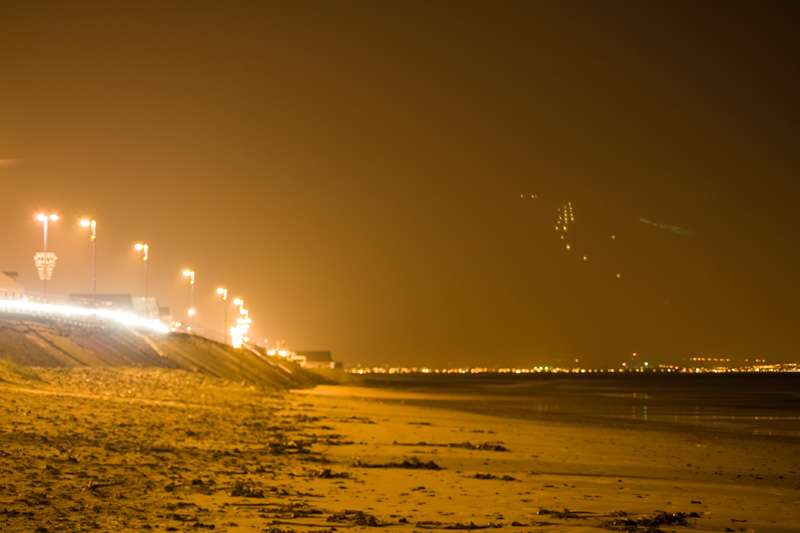
The flare is generally due to the presence of a protective filter in the camera, after the lens. The flare is a mirror ghost of the original bright object, with the image center serving as a point of symmetry (or point reflection).
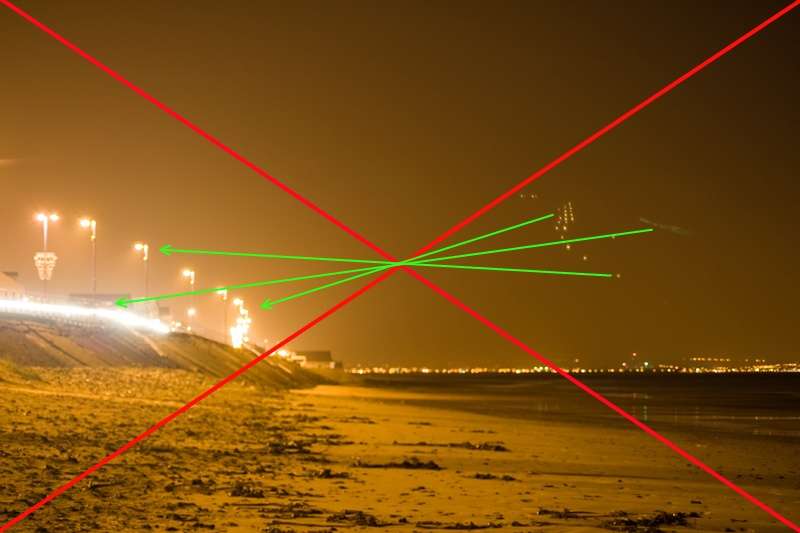

All dimensions are, most of the time, perfectly preserved, which suggests that reflections at planar surfaces are responsible.
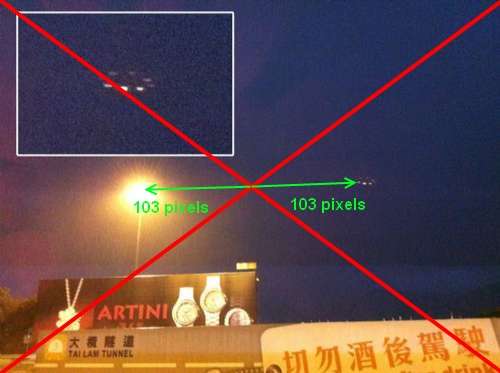
Let's see how it works with the figure below:
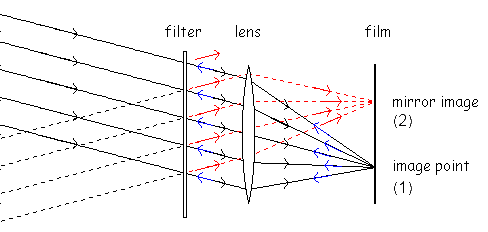
Black arrows indicate the light rays of a distant bright light source that form a regular image point on the film (1). Values for the reflectance of undeveloped photographic film vary from 15% to 40% [see sources 1,2], which makes the film a much stronger reflector than any optical component in the lens.
So, a significant percentage of the light is reflected off the film, partly specular and partly diffuse. (For convenience, we will consider that paths of the reflected light are the same and thus are already drawn for the incident light).
Thus, the blue arrows indicate light reflected from the film. This light encounters the filter, which specularly reflects a small fraction (red arrows). The red rays are parallel and consequently focused onto a point on the film. (2)
The virtual source of the mirror point is traced by the dashed black lines. Note that the blue rays reflected by the film seem odd from the viewpoint of specular reflection; they merely illustrate the fact that all light rays that originate from a single point on the film, and which are collected by the lens, emerge parallel at the filter.
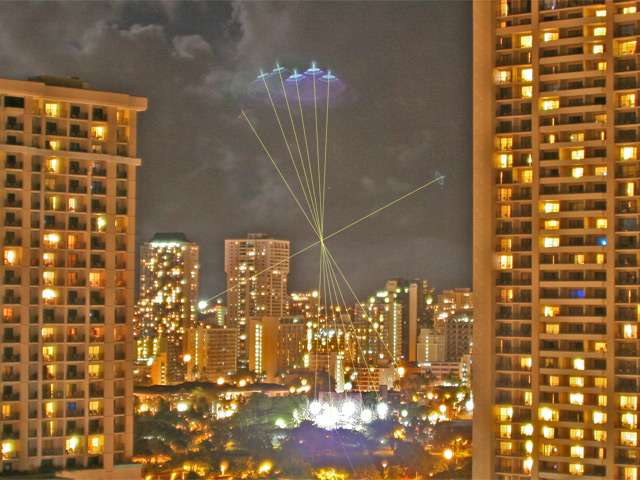
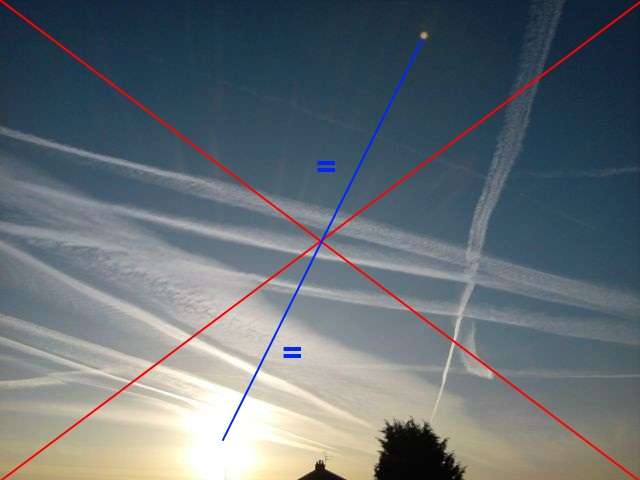
So, UFOs? No!

It's a very common source for UFO misidentification and one of the various flare effects that occurs when a bright light source is photographed or videotapped.
Usually, people who take photos/videos with this effect don't know how it's done and haven't seen anything with naked eye.
I'll explain here how it works in an optical and scientific way with some examples:

The flare is generally due to the presence of a protective filter in the camera, after the lens. The flare is a mirror ghost of the original bright object, with the image center serving as a point of symmetry (or point reflection).


All dimensions are, most of the time, perfectly preserved, which suggests that reflections at planar surfaces are responsible.

Let's see how it works with the figure below:

Black arrows indicate the light rays of a distant bright light source that form a regular image point on the film (1). Values for the reflectance of undeveloped photographic film vary from 15% to 40% [see sources 1,2], which makes the film a much stronger reflector than any optical component in the lens.
So, a significant percentage of the light is reflected off the film, partly specular and partly diffuse. (For convenience, we will consider that paths of the reflected light are the same and thus are already drawn for the incident light).
Thus, the blue arrows indicate light reflected from the film. This light encounters the filter, which specularly reflects a small fraction (red arrows). The red rays are parallel and consequently focused onto a point on the film. (2)
The virtual source of the mirror point is traced by the dashed black lines. Note that the blue rays reflected by the film seem odd from the viewpoint of specular reflection; they merely illustrate the fact that all light rays that originate from a single point on the film, and which are collected by the lens, emerge parallel at the filter.


So, UFOs? No!
reply to post by EvilSadamClone
excuse me i'm really new here to ATS as forum wise but yesterday evening i've witnessed UFOs in scarborough,toronto,canada where i'm from they where,I recorded footage with the best of my ability and hardware but hell i wasn't able to spot from phone it was like it was cloaked but i was able to see it perfectly with my eyes
youtu.be...
i don't have the cordinates cause i don't like being watching via GPS aka Geo Tagging..it would have helped i'm sorry for the zoom i forgot but this happened yesterday evening and i would like to know if anyone else saw something like it in scarborough,toronto
excuse me i'm really new here to ATS as forum wise but yesterday evening i've witnessed UFOs in scarborough,toronto,canada where i'm from they where,I recorded footage with the best of my ability and hardware but hell i wasn't able to spot from phone it was like it was cloaked but i was able to see it perfectly with my eyes
youtu.be...
i don't have the cordinates cause i don't like being watching via GPS aka Geo Tagging..it would have helped i'm sorry for the zoom i forgot but this happened yesterday evening and i would like to know if anyone else saw something like it in scarborough,toronto
new topics
-
JPMorgan Chase CEO warns World War III has already begun, mentions China, Russia
World War Three: 2 hours ago -
Outgoing President BARACK OBAMA - Secret Cryptic Call to the News Media on 1.17.2016.
Dissecting Disinformation: 6 hours ago
top topics
-
Trump thinks Liz Cheaney should be shot in the face?
US Political Madness: 16 hours ago, 14 flags -
Concerning data with regards to Turbo Cancer
Diseases and Pandemics: 15 hours ago, 12 flags -
Diddy's ex Jennifer Lopez urges Americans to trust her about Kamala Harris
Jokes, Puns, & Pranks: 14 hours ago, 8 flags -
Austin sends Fighter Squadrons, Tanker Aircraft to the Middle East
World War Three: 14 hours ago, 6 flags -
JPMorgan Chase CEO warns World War III has already begun, mentions China, Russia
World War Three: 2 hours ago, 6 flags -
Outgoing President BARACK OBAMA - Secret Cryptic Call to the News Media on 1.17.2016.
Dissecting Disinformation: 6 hours ago, 3 flags
active topics
-
Betting markets have Trump by a good bit
2024 Elections • 104 • : CriticalStinker -
Trump thinks Liz Cheaney should be shot in the face?
US Political Madness • 68 • : CarlLaFong -
JPMorgan Chase CEO warns World War III has already begun, mentions China, Russia
World War Three • 3 • : ADVISOR -
Breaking! Kamala Family Friend Confirms Race Hoax
US Political Madness • 118 • : Solvedit -
Tucker Carlson Shares Amazing Story: "I Was Mauled By a Demon"
Paranormal Studies • 38 • : Astrocometus -
Final jobs report before Nov 5th is a bad one lowest since Dec 2020
US Political Madness • 29 • : watchitburn -
Post A Funny (T&C Friendly) Pic Part IV: The LOL awakens!
General Chit Chat • 7711 • : Cymru -
Outgoing President BARACK OBAMA - Secret Cryptic Call to the News Media on 1.17.2016.
Dissecting Disinformation • 6 • : network dude -
CNN now has a pay wall
Other Current Events • 30 • : strongfp -
Tommy Robinson jailed again.
Mainstream News • 91 • : gortex
1
